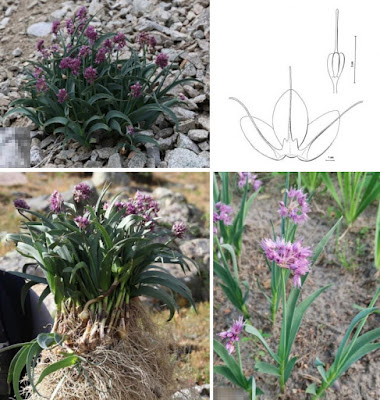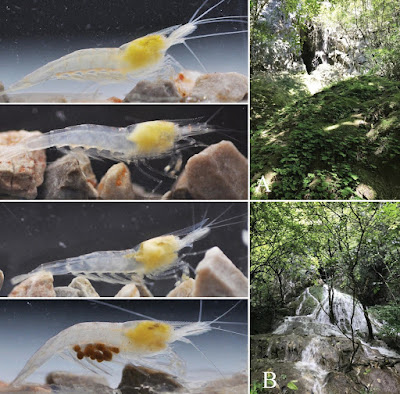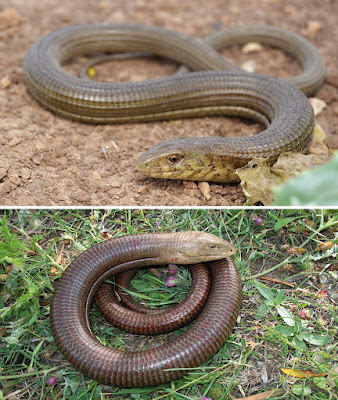[Most Recent Entries] [Calendar View]
Thursday, April 8th, 2021
| Time | Event | ||||||
| 3:49a | [Botany • 2021] Allium toksanbaicum (Amaryllidaceae) • A New Species from Southeast Kazakhstan
Abstract Allium toksanbaicum from South East Kazakhstan is described as a new species. Molecular markers reveal a close relationship to A. obliquum and some other central Asian species of the section Oreiprason. We investigated the phylogenetic relationship of the new species based on sequences of two chloroplast spacers (rpl32-trnL and trnQ-rps16) and the nuclear ribosomal DNA internal transcribed spacer (ITS) region. The new species is diploid with a chromosome number of 2n = 2x = 16. A detailed morphological description, illustrations and karyotype features of the new species are given. With its falcate leaves, the new species is very similar to A. carolinianum from the section Falcatifolia, but in the shape of the inflorescence and flowers it is very different from it. From A. obliquum it differs for the purple colour of flowers and filaments, as well as the presence of teeth at the base of inner stamens. Keywords: Allium sect. Oreiprason, chromosomes, ITS, plastid DNA, Monocots Allium toksanbaicum N.Friesen & Vesselova, sp. nov. It differs from the closely related Allium obliquum by purple perianth (not yellow), falcate leaves (not oblique), hemispherical and lax inflorescence, rounded bulbs (not oblong ovate) with coriaceous tunics. It differs from A. carolinianum by inner filaments with obtuse teeth at the base (not triangular without teeth), and rounded (not ovoid), bulbs with dirty yellow coriaceous (not brown, leathery) tunics. Etymology:— The epithet refers to the Toksanbai range. Distribution:— Kazakhstan, Toksanbai range, South Dzungaria Mountains (currently known from the type locality only). Ecology:— On the scree slopes in the alpine belt. Nikolai Friesen, Polina Vesselova, Bektemir Osmonali, Gulnara Sitpayeva, Alexander Luferov and Alexander Shmakov. 2021. Allium toksanbaicum (Amaryllidaceae), A New Species from Southeast Kazakhstan. Phytotaxa. 494(3); 251–267. DOI: 10.11646/phytotaxa.494.3.1 | ||||||
| 9:10a | [Crustacea • 2021] Caridina incolor • Integrative Taxonomy uncovers A New Stygobiotic Caridina Species (Decapoda, Caridea, Atyidae) from Guizhou Province, China Abstract Collecting much-needed information on the taxonomy, distribution, and ecology of cave-dwelling shrimp is vital for addressing the urgent challenges in conservation biodiversity in fragile cave ecosystems. Caridina incolor sp. nov., a new atyid shrimp from an underground stream of Yaoshui Cave, Daqikong scenic area, Libo County, Guizhou Province, southwestern China is described based on morphology and DNA analysis (mitochondrial COI). Caridina incolor sp. nov. differs from epigean congeners by its smaller eyes which range from reduced to completely blind; colorless body and appendages; long stylocerite and sixth abdominal segment; and relatively large eggs. In comparison to other cave species, Caridina incolor sp. nov. presents a long rostrum and stylocerite; slender sixth abdominal segment; and unique shape of the appendix masculina. Data on the habitat, ecology, and levels of threat are provided and suggest that it should be categorized as Critically Endangered (CR) under the current IUCN criteria. Keywords: Caridina, COI, conservation biodiversity, freshwater biodiversity, southwestern China, speleology, taxonomy Caridina incolor Diagnosis: Body and appendages without coloration, translucent. Rostrum slender, slightly elevated at base, reaching to base of 3rd segment of antennular peduncle to end of scaphocerite; straight, slightly sloping downwards, sometimes with tip turned upwards; rostral formula 6–10+11–27/4–15. First pereiopod carpus 0.83–0.91 × as long as chela, 2.3–2.7 × as long as high; chela 2.2–2.5 × as long as broad; fingers 1.1–1.4 × as long as palm. Second pereiopod carpus 1.3–1.4 × as long as chela, 5.4–5.6 × as long as high; chela 2.4–2.6 × as long as broad; fingers 1.6–1.8 × as long as palm. Third pereiopod propodus 3.8–4.0 × as long as dactylus, 13.6–14.4 × breadth, with 8–11 thin spines on the posterior and lateral margins. Fifth pereiopod propodus 4.0–4.7 × as long as dactylus, 17.6–20.5 × breadth, with 17–20 thin spines on the posterior and lateral margins, dactylus terminating in one claw, with 50–55 spinules on flexor margin. Endopod of male subrectangular, slightly wider proximally, length 0.39–0.46 × exopod length, 2.0–2.2 × proximal breadth, ending broadly rounded; inner margin slightly concave, bearing spine-like setae, outer margin slightly convex, proximally 1/3 bearing nearly equal length short spine-like setae, distally 2/3 bearing nearly equal length long spine-like setae, and top bearing nearly equal length stout spine-like setae; appendix interna well developed, arising from distal 1/3 of endopod, beyond the end of endopod, distally with cincinulli. Appendix masculina rod-shaped and gradually tapering into a triangular tip, reaching about 0.48–0.51 × length of endopod, with numerous long spined setae on proximal and distal regions; endopod reaching about 0.76–0.79 × length of exopod; appendix interna well developed, reaching about 0.58–0.78 × length of appendix masculina, with cincinulli distally. Uropodal diaeresis with 10–12 movable spinules. Females carry 10–15 eggs, size of undeveloped eggs (without eyespots) 0.83–0.88 × 1.18–1.26 mm. Etymology: Caridina incolor sp. nov. is named after the colorless and transparent body color. Shuo Feng, Qing-Hua Chen and Zhao-Liang Guo. 2021. Integrative Taxonomy uncovers A New Stygobiotic Caridina Species (Decapoda, Caridea, Atyidae) from Guizhou Province, China. ZooKeys. 1028: 29-47. DOI: 10.3897/zookeys.1028.63822 | ||||||
| 10:27a | [Herpetology • 2021] Pseudopus apodus levantinus • Morphological and Genetic Differentiation in the Anguid Lizard Pseudopus apodus (Anguidae) supports the Existence of An Endemic Subspecies in the Levant
Abstract The Levant represents one of the most important reptile diversity hotspots and centers of endemism in the Western Palearctic. The region harbored numerous taxa in glacial refugia during the Pleistocene climatic oscillations. Due to the hostile arid conditions in the warmer periods they were not always able to spread or come into contact with populations from more distant regions. One large and conspicuous member of the Levantine herpetofauna is the legless anguid lizard Pseudopus apodus. This species is distributed from the Balkans to Central Asia with a portion of its range running along the eastern Mediterranean coast. Mitochondrial and nuclear DNA sequences, microsatellite genotypes, and morphology show that populations in this region differ from the two named subspecies and presumably had a long independent evolutionary history during the Quaternary. Here we describe the Levantine population as a new subspecies and present biogeographic scenarios for its origin and diversification. The new subspecies is genetically highly diverse, and it forms a sister lineage to Pseudopus from the remaining parts of the range according to mtDNA. It is the largest-bodied of the three subspecies, but occupies the smallest range. Keywords: Middle East, mitochondrial DNA, microsatellites, Ophisaurus, phenotype, Reptiles, sheltopusik, Squamata
Pseudopus apodus levantinus ssp. nov. Jablonski, Ribeiro-Júnior, Meiri, Maza, Mikulíček, Jandzik The proposed common name in English, Hebrew, and Arabic: Levantine Glass Lizard, الشرق ,קמטן חורש לבנטיני, respectively. Diagnosis: A large Pseudopus (up to 610 mm snout-vent length, 1,367 mm total length and a mass of 1,100 g) that can be distinguished from the other two subspecies by a combination of the following characters (means followed by standard deviations; Table 4): (1) preanal scales (PAN) 10; (2) long body (SVL; 490.22 mm ± 76.15); (3) long tail (TL; 600.70 mm ± 107.04); (4) long head (HL1; from the ear aperture to the tip of the snout, 47.6 mm ± 7.99); pileus length (PL; mean 41.98 mm ± 6.78); and distance from the frontal shield to the tip of the snout (FSL; 17.27 mm ± 2.96); (5) wide head (HW1; maximum width, 32.04 mm ± 6.34); and width at the level of the posterior edge of the eyes orbits (HW2; 28.21 mm ± 4.95); (6) relatively long limb rudiments (RL; 5.55 mm ± 1.53) (see and Tables 3 and 4 for comparisons to P. a. apodus and P. a. thracius). Etymology: No name is available for the glass lizards from the Levantine region. We hence suggest a new name, Pseudopus apodus levantinus, as a reference to the isolated and allopatric distribution of this subspecies exclusively in the Levant region. This region covers present-day (western) Syria, Lebanon, (north-western) Jordan, Israel, West Bank, Cyprus, and most of Turkey south-east of the middle Euphrates, which is almost identical to the known distribution range of the new subspecies. The term “Levant” is derived from the Italian “Levante”, meaning “rising” and implying the rising of the Sun in the east as an equivalent to the Arabic “al-Mashriq” (المشـرق) and the Hebrew “Mizrāḥ” ((מִזְרָחboth meaning “east”.
Daniel Jablonski, Marco Antônio Ribeiro-Júnior, Shai Meiri, Erez Maza, Oleg V. Kukushkin, Marina Chirikova, Angelika Pirosová, Dušan Jelić, Peter Mikulíček and David Jandzik. 2021. Morphological and Genetic Differentiation in the Anguid Lizard Pseudopus apodus supports the Existence of An Endemic Subspecies in the Levant. Vertebrate Zoology. 71: 175-200. DOI: 10.3897/vz.71.e60800 We dedicate this article to Professor Fritz Jürgen Obst (1939–2018) acknowledging thus his precocious contribution to the taxonomy of Pseudopus (Ophisaurus) apodus published in Zoologische Abhandlungen (1978), today Vertebrate Zoology journal, 40 years before the information appeared about the possible existence of the subspecies described here. Abstract in Hebrew: הלבאנט מהווה את אחד האזורים העשירים ביותר במינים בכלל, במינים אנדמיים ובמגוון פילוגנטי של זוחלים בממלכה הפליארקטית. מינים רבים התקיימו באזור במהלך תקופות הקרח, כשהוא שימש מפלט מהאקלים הקר בצפון. אחד ממיני הזוחלים הגדולים והבולטים בלבאנט הוא קמטן החורש, Pseudopus apodus מין זה נפוץ מהבלקן בצפון אל מרכז אסיה במזרח, ומגיע בחוף הים התיכון המזרחי לגבול תפוצתו הדרומי. לפי רצפי DNA מיטוכונדריאלי, DNA גרעיני ומיקרוסטליטים, כמו גם נתוני צורה, גודל ודגמי צבע, נראה כי אוכלוסיות הלבנט של מין זה שונות משמעותית משני תתי המינים המתוארים המצויים מצפון ללבאנט. הנתונים מצביעים על כך שאוכלוסיות הלבאנט נפרדו מתתי המינים האחרים ומראות היסטוריה פילוגנטית עצמאית לאורך הרביעון. אנו מתארים את אוכלוסיות הלבאנט כתת מין חדש. ומציגים תרחישים אפשריים להסבר מוצאו והיפרדותו מתתי המינים האחרים. תת המין החדש הוא קבוצה אחות לשני תתי המינים המתוארים על פי הניתוח הגנטי. הוא הגדול בין תתי המינים, אך מאכלס את תחום התפוצה הקטן מבין כל השלושה. Abstract in Arabic: منطقة الشرق الاوسط تعتبر احدى اغنى المناطق بانواع الحيونات المختلفة بشكل عام, وبالعديد من الحيوانات المتوطنة ومجموعة متنوعة من الزواحف من مملكة Palearctic. كانت المنطقة تأوي العديد من الأنواع في الفترة الجليدية, اذ ان المنطقة كانت بمثابة ملجأ لها من برد المناطق الاكثر شمالاً. من احدى انواع الزواحف الكبيرة والبارزة في منطقة الشرق الاوسط هي السحلية Pseudopus apodus. هذا النوع من الزواحف ينتشر في الشمال من منطقة البلقان الى مركز آسيا في الشرق ويصل انتشاره حتى شواطئ البحر الابيض المتوسط الشمالية, والتي تعد اقصى منطقة جنوبية ينتشر بها.استنادا لتسلسل الحمض النووي الميتوكوندريالي والحمض الخلوي الصبغي, بالاضافة الى معلومات اخرى منها الشكل والحجم ونماذج من الالوان, نرى ان هذا النوع من السحلية التي تعيش في منطقة الشرق الاوسط يختلف كثيرا عن انواع اخرى المنتشرة في المناطق الاكثر شمالاً.تشير المعلومات الى ان مجموعات السحلية عديمة الارجل القاطنة بمنطقة الشرق الاوسط انفصلت من النُّويعات (انواع فرعية) الاخرى وتظهر تاريخ تطوري مستقل خلال العصر الرباعي. نصف هنا ان هذا النوع من السحالي يُصَنَّف كنُوَيع مختلف وجديد ونعرض احداث ممكنة لشرح اصلها وانفصالها من النويعات الاخرى .يبدو أن النوع الفرعي الجديد له علاقة قريبة (أُخت) مع النوعين الاخرين ,ورغم انه الاكبر حجما لكنه يحتل اصغر نطاق انتشار من بينها. |
| << Previous Day |
2021/04/08 [Calendar] |
Next Day >> |












